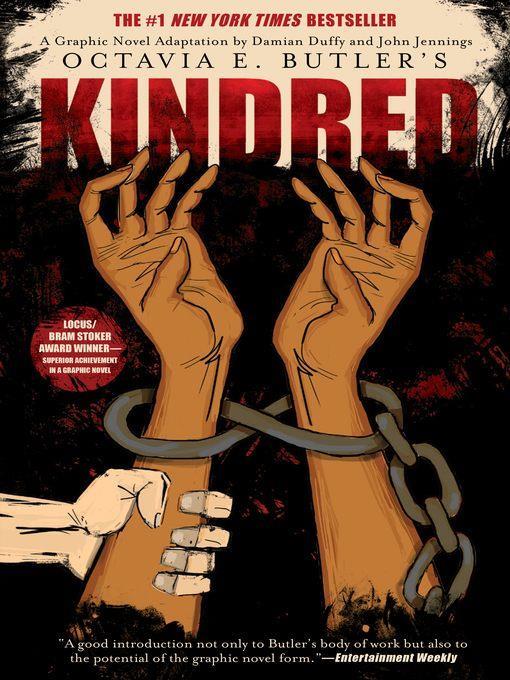
Kindred
A Graphic Novel Adaptation
فرمت کتاب
ebook
تاریخ انتشار
2017
Lexile Score
580
Reading Level
0-2
ATOS
3
Interest Level
9-12(UG)
نویسنده
Damian Duffyناشر
ABRAMSشابک
9781613128626
کتاب های مرتبط
- اطلاعات
- نقد و بررسی
- دیدگاه کاربران
نقد و بررسی

November 7, 2016
Dana, an African-American woman in the 1970s, is thrust backward in time to a 19th-century Maryland plantation. Over many visits to the past, she realizes that the spoiled son of the plantation owner is her ancestor, destined to father children with a slave, and she must protect his life to ensure her own existence. Butler’s celebrated 1979 novel, here adapted into a graphic novel, starts with a gripping idea and builds skillfully, as both Dana and her white husband in the present are warped by slavery and become complicit in its evil. This graphic novel recaps the classic source material faithfully without adding much to justify the adaptation, although it may find some new readers. The blocky artwork lacks the subtlety to evoke the complexity of the novel or the vividness of its historical settings (in addition to the antebellum South, the adaptation preserves the 1970s setting of the “present-day” sections). It’s an effective recap, clearly produced with great love and respect, but the book remains the gold standard.

April 1, 2017
In Duffy (Black Comix) and Jennings's (Blue Hand Mojo) adaptation of MacArthur Fellow Butler's iconic 1979 novel, time-traveler Dana discovers affinity and ugliness among her ancestors. Unwillingly wrenched from 1976 to 1815, she attempts to blend into plantation life as the "slave" of her white husband, Kevin, also drawn into the past. There Dana meets the slaveholder's spoiled son who rapes his servant-concubine to produce the line leading to Dana herself. Butler has claimed that she sanitized life under slavery for the novel, but Dana witnesses and experiences miseries aplenty, including whippings and mutilation. Indeed, Dana and Kevin are both greatly changed by the forced culture shock. Duffy covers the fullness of Butler's plot, while picking up much of the character complexity. The blocky, impressionistic, awkward art from Jennings lacks subtlety but effectively conveys the dystopian nature of plantation society via jarring color, contrasted with more sedate two-toned images for modern life. VERDICT This slave narrative through the eyes of a modern woman will continue to grip readers as they come to understand that "kindred" means all Americans, who together share the ancestry of slavery personally and collectively. Adults and teens.--MC
Copyright 2017 Library Journal, LLC Used with permission.

June 1, 2017
Gr 9 Up-A searing, painful, but necessary graphic novel adaptation of Butler's classic sci-fi work. It begins with a short glimpse at African American protagonist Dana's beaten physical state in the late 1970s and jumps briefly backward in time as she unpacks in her new home with her white husband Kevin. She is abruptly ripped from her present day to a plantation in antebellum Maryland, called there by the pained cries of her white ancestor Rufus. While Dana is in the past, time passes quickly, and she has to learn how to survive in horrendous conditions in order to protect her own future existence. She inexplicably returns to the present, where only a short time has passed, and eventually transports her husband to the past, where the white and black characters can't understand their interracial marriage. The couple continues to be torn apart by the sporadic time travel, and each time Dana hopes to reform Rufus as he grows older, but to no avail. The graphic scenes of violence, including intimations of rape, might shock readers, but they also serve to put history in stark and realistic light. Jennings's muted palette for the scenes in the 1970s and more vibrant hues in the mid-1800s serve as visual reminders of setting. The variation of the panels will catapult readers forward as the heroine slowly begins to understand how to manipulate the time travel. Inner monologues present Dana's own battles with complacency in a heartbreaking way. Strong language is appropriate for the horrific situations the characters find themselves in, and important themes of oppression, systemic racism and sexism, and survival are explored. VERDICT A compelling, masterly graphic novel for all libraries serving teens.-Shelley M. Diaz, School Library Journal
Copyright 2017 School Library Journal, LLC Used with permission.

January 1, 2017
The grande dame of sci-fi's 1979 novel is still widely, deservedly popular, and this graphic adaptation will lure in even more readers. Dana is a 1970s black woman repeatedly and involuntarily whisked back in time to a nineteenth-century plantation, where she becomes embroiled in the lives of the people enslaved there, risking everything by educating their children, even as she forms an uneasy and dangerous relationship with her own white ancestor. This adoring adaptation is dense enough to fully immerse readers in the perspective of a modern woman plunged into the thick of a culture where people are dehumanized by the act of dehumanizing others. It also preserves the vivid characterizations of the time traveler, her husband, and the enslaved people and the slaveholders, making the fantastical device that sets the story in motion a springboard for deeply humane insights. The heavily shaded, thick-lined, and rough-edged art lends a grimness appropriate to a life of jagged brutality and fearful uncertainty. Both a rewarding way to reexperience the tale and an accessible way to discover it.(Reprinted with permission of Booklist, copyright 2017, American Library Association.)

























دیدگاه کاربران